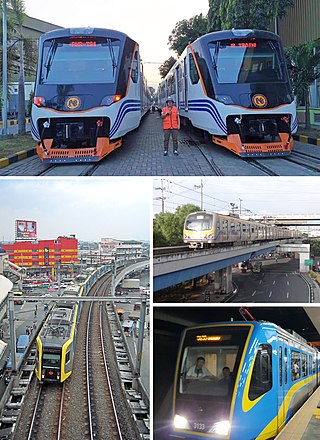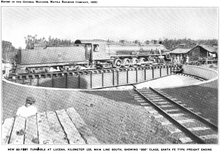
A diesel multiple unit or DMU is a multiple-unit train powered by on-board diesel engines. A DMU requires no separate locomotive, as the engines are incorporated into one or more of the carriages. Diesel-powered single-unit railcars are also generally classed as DMUs. Diesel-powered units may be further classified by their transmission type: diesel–mechanical DMMU, diesel–hydraulic DHMU, or diesel–electric DEMU.

The Philippine National Railways (PNR) is a state-owned railway company in the Philippines which operates one commuter rail service between Laguna and Quezon, and local services between Sipocot, Naga and Legazpi in the Bicol Region. It is an attached agency of the Department of Transportation.

Rail transportation in the Philippines is currently used mostly to transport passengers within Metro Manila and provinces of Laguna and Quezon, as well as a commuter service in the Bicol Region. Freight transport services once operated in the country, but these services were halted. However, there are plans to restore old freight services and build new lines. From a peak of 1,100 kilometers (680 mi), the country currently has a railway footprint of 533.14 kilometers (331.28 mi), of which only 129.85 kilometers (80.69 mi) are operational as of 2024, including all the urban rail lines. World War II, natural calamities, underspending, and neglect have all contributed to the decline of the Philippine railway network. In the 2019 Global Competitiveness Report, the Philippines has the lowest efficiency score among other Asian countries in terms of efficiency of train services, receiving a score of 2.4, and ranking 86th out of 101 countries globally. The government is currently expanding the railway network up to 1,900 kilometers (1,200 mi) by 2022 through numerous projects.
A limited express is a type of express train or express bus service that stops at fewer locations compared to other express services on the same or similar routes.

Santa Mesa station is a railway station located on the South Main Line in the city of Manila, Philippines. It is one of two stations in the line to have its own access road.

Tutuban station is the central railway terminus of the Philippine National Railways (PNR) network located in the city of Manila, Philippines.

The PNR 900 class is a class of 21 GE Universal Series diesel–electric locomotives operated by the Philippine National Railways since 1973. The locomotives comes with three different types: U14CP (1973), U14C (1979), and U15C (1991). Initially used for long-distance express services throughout Luzon, they were relegated to hauling commuter trains within Metro Manila, a task previously done by PNR's diesel multiple units fleet. This was further exacerbated by the closure of the PNR South Main Line's intercity section in 2012 after an accident in Sariaya, Quezon.

The PNR Metro Commuter Line was a commuter rail line operated by the Philippine National Railways. It was first inaugurated as the Metro Manila Commuter Service in 1970, and originally served the North Main Line and the South Main Lines, as well as the defunct Carmona and Guadalupe branch lines. Since then, it adopted several names such as Metrotrak and Metrotren, before adopting its present name in the late 2000s. The line was also nicknamed the Orange Line due to its designation in the 1970s.

The UM12C is a type of diesel-electric locomotive manufactured by GE for Southeast Asian rail operators. It is currently in service with the State Railway of Thailand. It was also operated by the Manila Railroad Company and the Philippine National Railways from 1956 until 1999. While the units for both companies feature a shovelnose layout, the MRR locomotives were single-ended and had a cowl unit cab, the SRT locomotives are double-ended cab forward units.

The Mindanao Railway, previously known as the Trans-Mindanao High Speed Railway, is a proposed railway system in Mindanao, the southernmost major island of the Philippines. Originally proposed in 1936 as part of Manuel L. Quezon's efforts to strengthen the presence of Commonwealth government in Mindanao against the rising influence of Imperial Japan before World War II, the line was shelved. Other proposals and studies were made in the 1950s, 1990s, and the 2000s, but never materialized. The current line began development in 2018; however, construction has yet to start. It will be initially built as a single-track standard gauge system to be operated by diesel-powered rolling stock, but will have provisions for upgrading to double-track and electrification through overhead lines.

The PNR South Main Line is one of the two trunk lines that form the Philippine National Railways' network in the island of Luzon, Philippines. It was opened in stages between 1916 and 1938 by the Manila Railroad. Services peaked in the 1940s until the late 1960s, when the system started to decline. Since 1988, it was the only functioning inter-city rail after its counterpart to the north, the North Main Line, was closed. The intercity section of the line in Laguna, Quezon and the Bicol Region was then closed and reopened repeatedly between 2004 and 2014 due to a combination of declining ridership and was closed since then. Currently, only a little more than half of line is operational as the line currently serves two commuter services, namely the Inter-Provincial Commuter from San Pedro to Lucena and the Bicol Commuter regional rail service between Sipocot, Naga Camarines Sur and Legazpi Albay, following the closure of the main line, the PNR Metro Commuter Line between Tutuban station and Laguna.

The Manila Railroad 200 class were 2-10-2 Santa Fe steam locomotives operated by the Manila Railroad Company (MRR), predecessor of the Philippine National Railways. They were built alongside the 4-8-2 Mountain-type 170 class by the American Locomotive Company at its Brooks facility between 1921 and 1922. During its service at the MRR, it carried heavy freight trains on the South Main Line between Manila and the Bicol Region.

The Manila Railway Dagupan class comprised thirty side tank locomotives. They were built for the Manila Railway Company between 1888 and 1890, and were the first true mainline locomotives in service of the Ferrocarril de Manila a Dagupan inter-city rail line, succeeding two of five Manila-class light-duty locomotives. One of these locomotives, No. 17 Urdaneta, survives today on static display in an open-air museum in Dagupan, Pangasinan.

The Manila Railroad 170 class were ten 4-8-2 Mountain steam locomotives operated by the Manila Railroad Company (MRR), predecessor of the Philippine National Railways. They were built alongside the 2-10-2 Santa Fe-type Manila Railroad 200 class by the American Locomotive Company at its Brooks facility between 1921 and 1922. During its service at the MRR, it carried passenger trains on the South Main Line between Manila and the Bicol Region.

The PNR South Long Haul, also known as the PNR Bicol, is a stalled inter-city rail line project in southern Luzon, Philippines. It is part of the larger Luzon Rail System, a network of long-distance standard-gauge lines being built by the Philippine National Railways throughout Luzon. It is one of the two lines that will reconstruct the historic PNR South Main Line, along with the electrified North–South Commuter Railway South section to Calamba, Laguna.

The PNR North Main Line is one of the two trunk lines of the Philippine National Railways in the island of Luzon, the other being the PNR South Main Line. The line during its maximum extent led to various cities and municipalities in Central Luzon and the Ilocos Region.

The PNR EM10000 class is an electric multiple unit commuter trainset that will be operated by the Philippine National Railways on the North–South Commuter Railway. Prior to the reveal of its numbering scheme in October 2021, the train was known as the PNR Sustina Commuter. Set to enter service by 2028, it will be PNR's first trainset to be run on standard gauge and powered by electric traction. The trains are also designed to be interoperable with the Metro Manila Subway.

The Manila Railroad 800 class USA were 45 United States Army Transportation Corps class S118 steam locomotives used by the Manila Railroad Company and the Philippine National Railways. Originally built by Vulcan Iron Works and the American Locomotive Works for the United States Army during the Second Philippines Campaign, they were later used to pull freight trains and temporary passenger trains. After the dieselization of the Manila Railroad network in the mid-1950s, they were relegated to work trains until the last unit was scrapped after appearing in a 1989 World War II movie.

The Manila Railway 70 class of 1908 was a class of at least twenty-two 0-6-2 side and well-tank locomotives built by the North British Locomotive Company. These locomotives were first put into service on a mainline during the late 1900s and early 1910s by the Manila Railway Company. Their primary purpose was to support the growing network and replace the aging Dagupan class engines. They were used on all the lines of the Manila Railway and its succeeding incarnation, the Manila Railroad. Over time, some locomotives were either scrapped or given to sugarcane plantations after being withdrawn. The last unit, No. 79, remained in service with the Pampanga Sugar Development Company as late as 1989.





























